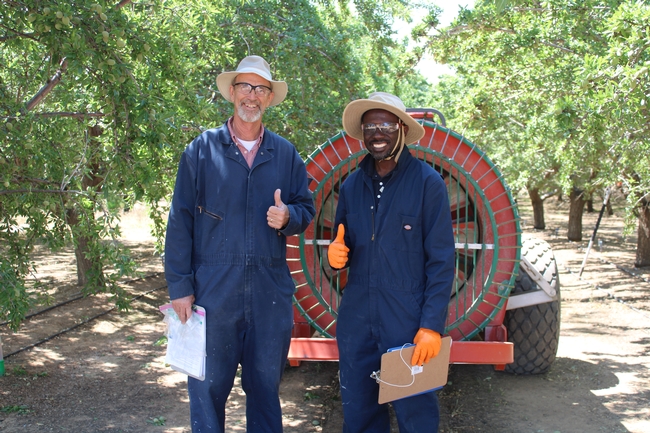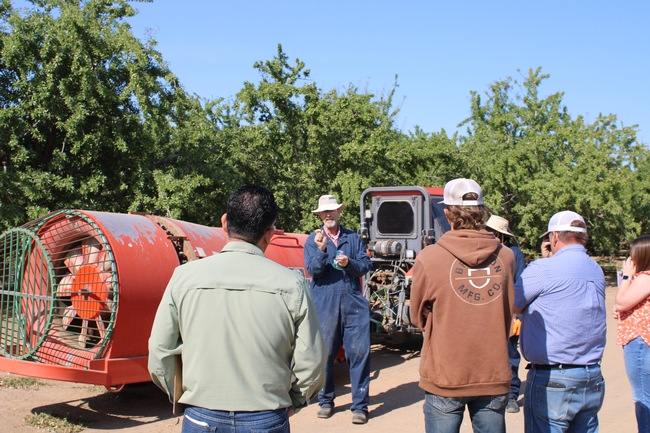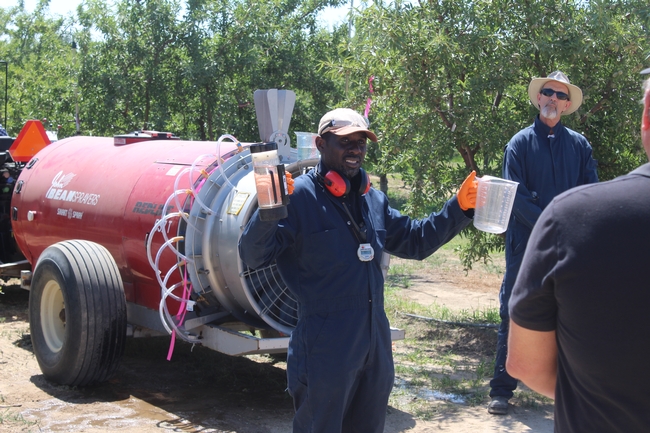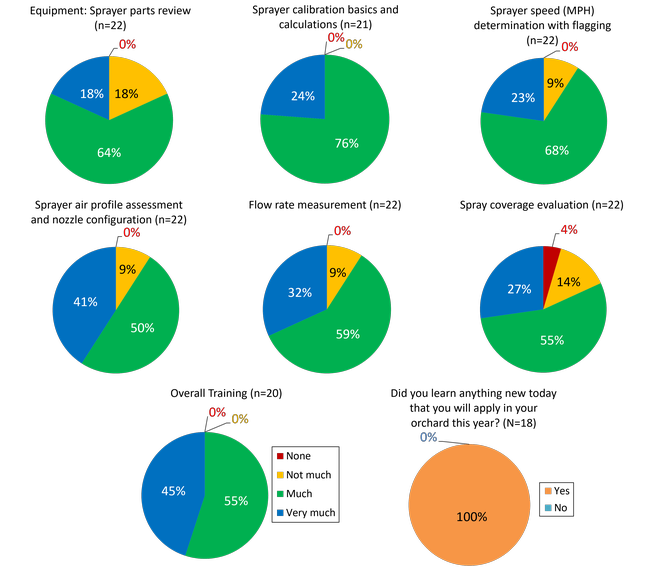UC ANR supports California's almond crop protection workforce through Airblast Sprayer Calibration Trainings to maintain or improve their technical knowledge. 100% of participants reported both learning professional skills and their intent to adopt practices that can improve the sustainability and profitability of California ag.
The Issue
For efficient and effective pesticide spray application, all sprayers should be calibrated as often as necessary throughout the growing season of almonds, especially when dealing with orchards of different ages and sizes. Calibration is considered a best practice in pesticide spray application ensuring accurate application rates and adherence to pesticide labels which is the law. As such, proper understanding of sprayer calibration objectives and steps is needed to avoid using incorrect methods that give a false sense of accuracy. Educating growers and applicators in calibration methods will therefore empower them to ensure the use of properly calibrated sprayers well-adjusted to the target canopy to deliver maximum crop protection while minimizing pesticide loss.
How UC Delivers
In June 2023, UC ANR co-hosted two Calibration Safety & Compliance Training events, one for Northern California and the other for Central California, with the Almond Board of California (ABC), AgSafe Food and Farms (AgSafe), and the Western Agricultural Processors Association (WAPA). The Northern California training was held at the Nickels Soil Lab in Arbuckle, CA, while the Central California event took place at the UC's Kearney Agricultural Research and Extension (KARE) Center in Parlier, CA. The events were aimed at providing practical calibration training on how to prepare and calibrate airblast sprayers as well as compliance training such as how to manage required documents for pesticide applications. The 4.5-hour trainings included “Welcome” by the ABC, “Regulatory Update” by WAPA, “Calibration Training” by UC ANR, “Headquarters Compliance Training” by AgSafe, and “DPR Laws & Regulations Update” also by AgSafe. The DPR approved 4.0 hours of continuing education credits – 2.0 ‘Laws' and 2.0 ‘Other' – for qualifying participants. Overall, 50+ attendees participated in both events: 30+ in Arbuckle and 23 in Parlier.
The Calibration Training by UC ANR was a 2-hour practical session conducted in an almond orchard along with airblast sprayer demonstrations. It was presented in an interactive format allowing participants to interject with questions, comments, and observations. The Northern California training was led by UC Cooperative Extension advisor Dr. Franz Niederholzer in collaboration with UC Cooperative Extension specialist Dr. Peter Ako Larbi. Alternatively, the Central California training was led by Dr. Larbi in collaboration with Dr. Niederholzer. Both sections covered: “Sprayer parts review”; “Sprayer calibration basics and calculations”; “Sprayer speed determination”; “Sprayer air profile assessment and nozzle configuration”; “Flow rate measurement”; and “Spray coverage evaluation”. Staff from the Nickels Soil Lab, the Agricultural Application Engineering (AgAppE) Lab, and KARE Center provided Logistical, technical, and documentation support. The participants completed evaluation forms to provide feedback for just the Calibration Training section. Comments from the evaluation forms included…
“Very good class.”
“Great rapport with participants.”
The Impact
In all, 22 participants provided feedback on their learning for the combined Calibration Training sections for the Northern and Central California events. Overall, 100% reported “much” to “very much” learning from the combined Calibration Training sections indicating that they were very effective and provided participants with a great amount of learning. Likewise, 100% also indicated their intent to adopt the practices learned from the section. Looking at each section of the training, 82% reported learning “much” to “very much” from the “Sprayer parts review”, 100% the same for “Sprayer calibration basics and calculations”, 91% for “Sprayer speed determination with flagging”, 91% for “Sprayer air profile assessment and nozzle configuration”, 91% for “Flow rate measurement”, and 82% for “Spray coverage evaluation” (full breakdown of feedback by section in the graphic below). Additional written comments were mostly positive.
The needs assessment conducted by Dr. Larbi for his Agricultural Application Engineering Program in 2019 showed that 56% of perennial specialty crop growers and applicators in the San Joaquin Valley used airblast sprayers, 12% used tower sprayers, 15% used electrostatic mist blowers, and 17% used other sprayers. Also, 22% calibrated their sprayers 10 or more times a year, 32% calibrated 4-6 times, and 46% calibrated only 1-3 times a year. According to the California Pesticide Use Report, in 2021, 456,802 pesticide applications delivered 34,323,828 lbs. of pesticide across 24,147,968 acres of almond orchards. This amounts to 75.14 lbs. per application or 1.42 lbs. per acre. If even 1% of the application was overapplied and another 1% was underapplied due to using uncalibrated sprayers in the year (a conservative guess if nearly half of applicators only calibrate 1-3 years times a year), then 686,477 lbs would have been misapplied leading to either reduced pest control or increased pesticide loading on the environment. This number is very significant considering that the situation does not apply to only almond production. Thus, by increasing the competency of California's almond crop protection workforce for properly calibrating sprayers as a best practice, UC ANR potentially improved environmental sustainability.
UCCE academics Dr. Niederholzer and Dr. Larbi have an extended collaboration in providing spray application and sprayer calibration training in both Northern and Central California since 2019. The results presented here exemplify the impact of such trainings. Expanding this collaboration to include industry stakeholders reaches other audiences, potentially new participants, and increases the extent of impact. UC ANR will continue to support California agriculture through such trainings and the dissemination of science-based information to promote operational efficiency and profitability.



